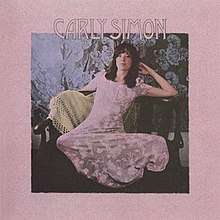Carly Simon (album)
Carly Simon is the debut studio album by singer-songwriter Carly Simon, released in February 1971 by Elektra Records. The album was produced by Eddie Kramer, who had previously worked with Joe Cocker and Jimi Hendrix.
| Carly Simon | ||||
|---|---|---|---|---|
 | ||||
| Studio album by | ||||
| Released | February 9, 1971 | |||
| Recorded | 1970–1971 | |||
| Studio | Electric Lady Studios, New York City, New York, U.S. | |||
| Genre | ||||
| Length | 38:26 | |||
| Label | Elektra | |||
| Producer | Eddie Kramer | |||
| Carly Simon chronology | ||||
| ||||
The album included her first top 10 hit, "That's the Way I've Always Heard It Should Be", a somber ballad centered on a woman pondering marriage with a sense of both inevitability and entrapment; the song was written by Simon and collaborator Jacob Brackman. The album features material written by Simon, with additional writing by Brackman, Kramer, and Freddy Gardner. The album also features covers of songs by Mark Klingman and Buzzy Linhart.
| Review scores | |
|---|---|
| Source | Rating |
| Allmusic | |
| Christgau's Record Guide | C–[2] |
| Uncut | |
Critical reception
Carly Simon was mostly well received by critics when released. Timothy Crouse, writing in Rolling Stone, stated "Carly's voice perfectly matches her material" and her "...superbly controlled voice is complemented by deft arrangements."[4] Robert Christgau was less impressed in The Village Voice: "I suppose it makes sense not only for the privileged to inflict their sensibilities on us, but for many of us to dig it."[5] In more recent years, William Ruhlmann, writing for Allmusic, gave the album a three and a half star rating out of a possible five, and stated "That's the Way I've Always Heard It Should Be" and "Dan, My Fling", were the stand-out tracks.
In a retrospective assessment, music scholar Kim Simpson deemed "That's the Way I've Always Heard It Should Be" an "early soft rock masterpiece."[6]
Simon stated in the Ask Carly section on her website that "Reunions" was her mother's—Andrea Simon—favorite song of hers.
Awards
| Year | Nominee / work | Award | Result |
|---|---|---|---|
| 1972 | "That's the Way I've Always Heard It Should Be" | Best Pop Vocal Performance, Female | Nominated |
| Carly Simon | Best New Artist | Won |
Track listing
| No. | Title | Writer(s) | Length |
|---|---|---|---|
| 1. | "That's the Way I've Always Heard It Should Be" | 4:15 | |
| 2. | "Alone" | Simon | 3:36 |
| 3. | "One More Time" | Simon | 3:32 |
| 4. | "The Best Thing" | Simon | 4:14 |
| 5. | "Just a Sinner" | Moogy Klingman | 3:10 |
| No. | Title | Writer(s) | Length |
|---|---|---|---|
| 6. | "Dan, My Fling" |
| 5:28 |
| 7. | "Another Door" | Simon | 3:16 |
| 8. | "Reunions" |
| 3:06 |
| 9. | "Rolling Down the Hills" | Simon | 3:35 |
| 10. | "The Love's Still Growing" | Buzzy Linhart | 4:14 |
| Total length: | 38:26 | ||
Personnel
- Carly Simon – vocals, guitar, piano
- Jeff Baxter – pedal steel guitar
- David Bromberg – guitar
- Ed Freeman – string arrangements (1, 8, 10)
- Paul Griffin – keyboards
- Mark "Moogy" Klingman – keyboards
- Jerry Jemmott – bass guitar
- Jimmy Johnson – guitar
- Tony Levin – bass guitar
- Billy Mernit – keyboards
- Pat Rebillot – string arrangements (2)
- Harvey Shapiro – cello
- Jim Wilkins – bass guitar
- John Siomos - drums
Technical personnel
- Producer: Eddie Kramer
- Engineered and Mixed by Eddie Kramer and Dave Palmer
- Art Direction and Design: Robert L. Heimall
- Cover Photography and Poster: Peter Simon
- Back Cover Photo: Joel Brodsky[7]
Charts
Album - Billboard (North America)
| Year | Chart | Position |
|---|---|---|
| 1971 | Pop Albums | 30 |
Album - International
| Year | Country | Position |
|---|---|---|
| 1971 | Australia | 55[8] |
| 1971 | Canada | 17[9] |
Singles - Billboard (North America)
| Year | Single | Chart | Position |
|---|---|---|---|
| 1971 | "That's The Way I've Always Heard It Should Be" | Adult Contemporary | 6 |
| 1971 | "That's The Way I've Always Heard It Should Be" | Pop Singles | 10 |
References
- Ruhlmann, William. Carly Simon at AllMusic. Retrieved 12 July 2007.
- Christgau, Robert (1981). "Consumer Guide '70s: S". Christgau's Record Guide: Rock Albums of the Seventies. Ticknor & Fields. ISBN 089919026X. Retrieved March 12, 2019 – via robertchristgau.com.
- "Carly Simon Carly Simon > Review". Uncut. Retrieved 23 December 2009.
- Crouse, Timothy (April 1, 1971). "Carly Simon > Album Review". Rolling Stone (79). Retrieved 7 November 2011.
- Christgau, Robert (August 19, 1971). "Consumer Guide: Carly Simon". The Village Voice. Retrieved 7 November 2011.
- Simpson, Kim. Early '70s Radio: The American Format Revolution. A&C Black. p. 89. ISBN 978-1-441-15758-4.
- Kent, David (1993). Australian Charts Book 1970—1992. Australian Chart Book Pty Ltd, Turramurra, N.S.W. ISBN 0-646-11917-6.
- "CAN Charts > Carly Simon". RPM. Archived from the original on 4 January 2015. Retrieved 4 January 2015.